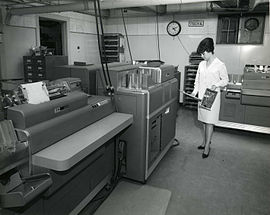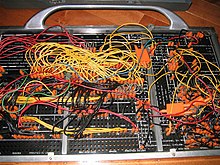
In computing, a printer is a peripheral machine which makes a persistent representation of graphics or text, usually on paper. While most output is human-readable, bar code printers are an example of an expanded use for printers. Different types of printers include 3D printers, inkjet printers, laser printers, and thermal printers.

A teleprinter is an electromechanical device that can be used to send and receive typed messages through various communications channels, in both point-to-point and point-to-multipoint configurations. Initially they were used in telegraphy, which developed in the late 1830s and 1840s as the first use of electrical engineering, though teleprinters were not used for telegraphy until 1887 at the earliest. The machines were adapted to provide a user interface to early mainframe computers and minicomputers, sending typed data to the computer and printing the response. Some models could also be used to create punched tape for data storage and to read back such tape for local printing or transmission.

A line printer prints one entire line of text before advancing to another line. Most early line printers were impact printers.

The IBM 1620 was announced by IBM on October 21, 1959, and marketed as an inexpensive scientific computer. After a total production of about two thousand machines, it was withdrawn on November 19, 1970. Modified versions of the 1620 were used as the CPU of the IBM 1710 and IBM 1720 Industrial Process Control Systems.

Starting at the end of the nineteenth century, well before the advent of electronic computers, data processing was performed using electromechanical machines collectively referred to as unit record equipment, electric accounting machines (EAM) or tabulating machines. Unit record machines came to be as ubiquitous in industry and government in the first two-thirds of the twentieth century as computers became in the last third. They allowed large volume, sophisticated data-processing tasks to be accomplished before electronic computers were invented and while they were still in their infancy. This data processing was accomplished by processing punched cards through various unit record machines in a carefully choreographed progression. This progression, or flow, from machine to machine was often planned and documented with detailed flowcharts that used standardized symbols for documents and the various machine functions. All but the earliest machines had high-speed mechanical feeders to process cards at rates from around 100 to 2,000 per minute, sensing punched holes with mechanical, electrical, or, later, optical sensors. The operation of many machines was directed by the use of a removable plugboard, control panel, or connection box. Initially all machines were manual or electromechanical. The first use of an electronic component was in 1937 when a photocell was used in a Social Security bill-feed machine. Electronic components were used on other machines beginning in the late 1940s.

The IBM 1403 line printer was introduced as part of the IBM 1401 computer in 1959 and had an especially long life in the IBM product line.

The Friden Flexowriter produced by the Friden Calculating Machine Company, was a teleprinter, a heavy-duty electric typewriter capable of being driven not only by a human typing, but also automatically by several methods, including direct attachment to a computer and by use of paper tape.

A keypunch is a device for precisely punching holes into stiff paper cards at specific locations as determined by keys struck by a human operator. Other devices included here for that same function include the gang punch, the pantograph punch, and the stamp. The term was also used for similar machines used by humans to transcribe data onto punched tape media.

The IBM 407 Accounting Machine, introduced in 1949, was one of a long line of IBM tabulating machines dating back to the days of Herman Hollerith. It had a card reader and printer; a summary punch could be attached. Processing was directed by a control panel.

The IBM 1132 line printer was the normal printer for the IBM 1130 computer system. It printed 120 character lines at 80 lines per minute. The character set consisted of numbers, upper-case letters and some special characters.

The tabulating machine was an electromechanical machine designed to assist in summarizing information stored on punched cards. Invented by Herman Hollerith, the machine was developed to help process data for the 1890 U.S. Census. Later models were widely used for business applications such as accounting and inventory control. It spawned a class of machines, known as unit record equipment, and the data processing industry.

A plugboard or control panel is an array of jacks or sockets into which patch cords can be inserted to complete an electrical circuit. Control panels are sometimes used to direct the operation of unit record equipment, cipher machines, and early computers.
The IBM 2780 and the IBM 3780 are devices developed by IBM to perform remote job entry (RJE) and other batch functions over telephone lines; they communicate with the mainframe via Binary Synchronous Communications and replaced older terminals using synchronous transmit-receive (STR). In addition, IBM has developed workstation programs for the 1130, 360/20, 2922, System/360 other than 360/20, System/370 and System/3.

Continuous stationery (UK) or continuous form paper (US) is paper which is designed for use with dot-matrix and line printers with appropriate paper-feed mechanisms. Other names include fan-fold paper, sprocket-feed paper, burst paper, lineflow, tractor-feed paper, and pin-feed paper. It can be single-ply or multi-ply, often described as multipart stationery or forms. Continuous stationery is often used when the final print medium is less critical in terms of the appearance at the edges, and when continuously connected individual sheets are not inconvenient for the application. Individual sheets can be separated at the perforation, and sheets also have edges with punched holes, which also can be removed at the perforation.

A computer punched card reader or just computer card reader is a computer input device used to read computer programs in either source or executable form and data from punched cards. A computer card punch is a computer output device that punches holes in cards. Sometimes computer punch card readers were combined with computer card punches and, later, other devices to form multifunction machines. It is a input device and also an output device. Most early computers, such as the ENIAC, and the IBM NORC, provided for punched card input/output. Card readers and punches, either connected to computers or in off-line card to/from magnetic tape configurations, were ubiquitous through the mid-1970s.

The IBM 421 accounting machine saw use in the 1960s.
IBM 3740 Data Entry System was a data entry system that was announced by IBM in 1973. It recorded data on an 8" diskette, a new recording medium from IBM, for fast, flexible, efficient data entry to either high-production, centralized operations or to decentralized, remote operations. The "Diskette" was more commonly known as an 8-inch floppy disk.
The IBM 1443 Printer is an obsolete computer line printer used in the punched card era. It was offered in three models: Models 1, 2 and N1; the last two could print up to 240 lines per minute (LPM) with a full character set.

IBM designed, manufactured and sold optical mark and character readers from 1960 until 1984. The IBM 1287 is notable as being the first commercially sold scanner capable of reading handwritten numbers.


















